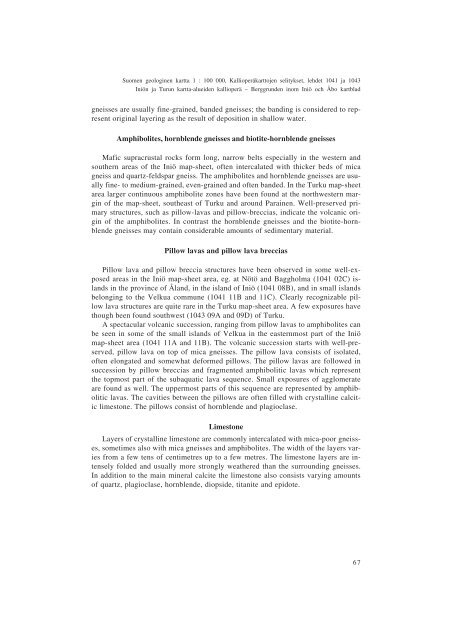Ritva Karhunen - arkisto.gsf.fi - Geologian tutkimuskeskus
Ritva Karhunen - arkisto.gsf.fi - Geologian tutkimuskeskus
Ritva Karhunen - arkisto.gsf.fi - Geologian tutkimuskeskus
Create successful ePaper yourself
Turn your PDF publications into a flip-book with our unique Google optimized e-Paper software.
Suomen geologinen kartta 1 : 100 000, Kallioperäkarttojen selitykset, lehdet 1041 ja 1043<br />
Iniön ja Turun kartta-alueiden kallioperä – Berggrunden inom Iniö och Åbo kartblad<br />
gneisses are usually <strong>fi</strong>ne-grained, banded gneisses; the banding is considered to represent<br />
original layering as the result of deposition in shallow water.<br />
Amphibolites, hornblende gneisses and biotite-hornblende gneisses<br />
Ma<strong>fi</strong>c supracrustal rocks form long, narrow belts especially in the western and<br />
southern areas of the Iniö map-sheet, often intercalated with thicker beds of mica<br />
gneiss and quartz-feldspar gneiss. The amphibolites and hornblende gneisses are usually<br />
<strong>fi</strong>ne- to medium-grained, even-grained and often banded. In the Turku map-sheet<br />
area larger continuous amphibolite zones have been found at the northwestern margin<br />
of the map-sheet, southeast of Turku and around Parainen. Well-preserved primary<br />
structures, such as pillow-lavas and pillow-breccias, indicate the volcanic origin<br />
of the amphibolites. In contrast the hornblende gneisses and the biotite-hornblende<br />
gneisses may contain considerable amounts of sedimentary material.<br />
Pillow lavas and pillow lava breccias<br />
Pillow lava and pillow breccia structures have been observed in some well-exposed<br />
areas in the Iniö map-sheet area, eg. at Nötö and Baggholma (1041 02C) islands<br />
in the province of Åland, in the island of Iniö (1041 08B), and in small islands<br />
belonging to the Velkua commune (1041 11B and 11C). Clearly recognizable pillow<br />
lava structures are quite rare in the Turku map-sheet area. A few exposures have<br />
though been found southwest (1043 09A and 09D) of Turku.<br />
A spectacular volcanic succession, ranging from pillow lavas to amphibolites can<br />
be seen in some of the small islands of Velkua in the easternmost part of the Iniö<br />
map-sheet area (1041 11A and 11B). The volcanic succession starts with well-preserved,<br />
pillow lava on top of mica gneisses. The pillow lava consists of isolated,<br />
often elongated and somewhat deformed pillows. The pillow lavas are followed in<br />
succession by pillow breccias and fragmented amphibolitic lavas which represent<br />
the topmost part of the subaquatic lava sequence. Small exposures of agglomerate<br />
are found as well. The uppermost parts of this sequence are represented by amphibolitic<br />
lavas. The cavities between the pillows are often <strong>fi</strong>lled with crystalline calcitic<br />
limestone. The pillows consist of hornblende and plagioclase.<br />
Limestone<br />
Layers of crystalline limestone are commonly intercalated with mica-poor gneisses,<br />
sometimes also with mica gneisses and amphibolites. The width of the layers varies<br />
from a few tens of centimetres up to a few metres. The limestone layers are intensely<br />
folded and usually more strongly weathered than the surrounding gneisses.<br />
In addition to the main mineral calcite the limestone also consists varying amounts<br />
of quartz, plagioclase, hornblende, diopside, titanite and epidote.<br />
67

















